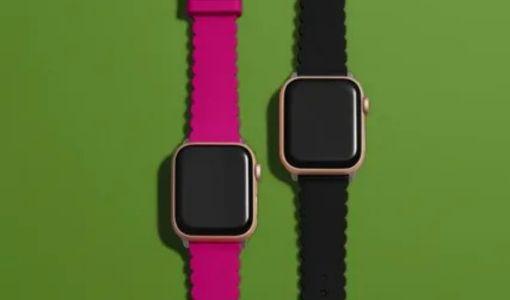Silicone Apple Watch bands have become a popular choice for users due to their comfort, flexibility, and water resistance. Whether you're a fitness enthusiast or a casual wearer, these bands offer both practicality and style. But one of the most common questions Apple Watch users ask is: How long do silicone Apple Watch bands typically last? Let’s dive into what affects their durability, how to extend their lifespan, and when it might be time for a replacement.
What Are Silicone Apple Watch Bands Made Of?
Silicone is a synthetic material made from silicon, oxygen, carbon, and hydrogen. It’s known for its heat resistance, flexibility, and non-toxic properties. These characteristics make it ideal for wearable accessories like watch bands. Silicone Apple Watch bands are typically made from fluoroelastomer—a high-performance, durable type of silicone that resists heat, sweat, and UV exposure.
This material also repels water and is easy to clean, which is essential for people with active lifestyles. However, like all materials, silicone is subject to wear and tear over time, depending on usage and maintenance.
Average Lifespan of Silicone Apple Watch Bands
On average, silicone Apple Watch bands can last anywhere from 12 to 24 months with regular use. For casual users who wear the band intermittently, the band may last up to three years or more. Conversely, for those who wear their Apple Watch daily—especially during workouts or in harsh conditions—the band may show signs of wear sooner.
Several factors affect how long your silicone band lasts:
- Frequency of Use: Daily wearers may notice quicker deterioration.
- Exposure to Elements: Sunlight, saltwater, and chemicals can weaken the silicone over time.
- Skin Oils and Sweat: Constant contact with sweat and skin oils can lead to discoloration or stickiness.
- Cleaning Habits: Proper care can significantly extend a band's life.
Signs Your Silicone Band Needs Replacing
Even though silicone is resilient, it won’t last forever. Here are clear signs that your silicone Apple Watch band is due for a replacement:
- Cracking or Splitting: Small cracks can turn into breaks if left unaddressed.
- Discoloration: While some fading is normal, severe color change or staining can signal degradation.
- Stickiness: If the band feels sticky even after cleaning, it may be breaking down chemically.
- Loss of Flexibility: A brittle or stiff band can become uncomfortable or unsafe.
- Unpleasant Odor: Persistent smells even after cleaning suggest it's time for a new band.
Noticing any of these issues early can prevent discomfort or even skin irritation.
How to Extend the Lifespan of Silicone Bands
Proper care goes a long way in keeping your silicone Apple Watch bands in great condition. Here are some simple tips:
- Regular Cleaning: Wipe down the band after workouts with a damp cloth. Use mild soap and water weekly.
- Avoid Harsh Chemicals: Do not use alcohol-based cleaners, bleach, or abrasive materials on the band.
- Dry Thoroughly: After cleaning or swimming, make sure the band is completely dry before putting it back on.
- Rotate Bands: If you own multiple bands, switch them out regularly to reduce constant wear on one.
- Store Properly: Keep unused bands in a cool, dry place away from direct sunlight.
By following these simple steps, you can maintain the look and functionality of your band for a longer period.
Are Premium Silicone Bands More Durable?
There’s a wide range of silicone Apple Watch bands available—from inexpensive third-party options to premium Apple-made bands. While third-party bands may be more affordable, not all use the same high-quality materials. Genuine Apple bands typically use fluoroelastomer, which is more durable and skin-friendly.
Premium bands tend to last longer due to better manufacturing practices and higher-quality silicone. Still, even with premium options, the band’s lifespan will depend heavily on how it’s used and maintained.
Final Thoughts: When to Replace Your Band
Silicone Apple Watch bands are ideal for daily use, offering both comfort and resilience. Typically, these bands last between 1 to 2 years, depending on usage and care. For those who wear their Apple Watch daily or in extreme conditions, it’s smart to inspect the band regularly for signs of damage or wear.
Replacing your band at the right time ensures your watch remains secure and comfortable. Plus, switching bands is an easy and affordable way to refresh your Apple Watch’s style.
If you’ve noticed wear on your current band, or if it just doesn't feel as good as it once did, it might be time to consider a replacement. With many options available, including vibrant colors and sleek finishes, upgrading your silicone Apple Watch band can be both functional and fashionable.

